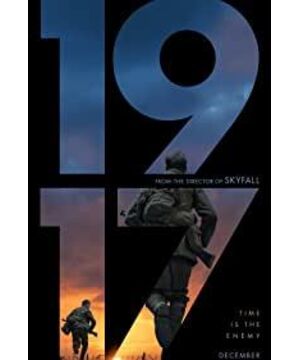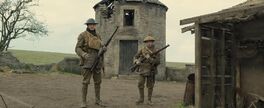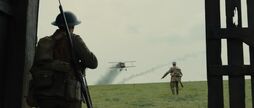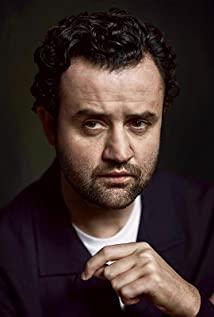In 1962, Bob Dylan created the song "Blowing in the Wind" with deep understanding and mastery of current affairs. This is his earliest anti-war song, which not only repeated many things in the world. Cross-examination, I hope that the world can resolve disputes in a peaceful and rational manner, stop turning a blind eye to and deaf to the misfortunes of the world, let alone let innocent people continue to lose their lives in the flames of war, and how to deal with people in the world, especially It is the concept of individualism that raises doubts about the definition of a real man.
In the war film "1917", the so-called "one mirror to the end, immersive battle" created by the door guide with great painstaking efforts, the one that will always be the first to be impressed is the most distinctive label on its selling point: long shots, but in First, press the form of the long shot, focusing on the analysis of the story. The story of "1917", first of all, most intuitively, is a story presented under a linear narrative. Naturally, the time corresponding to the story is also linear. The single time dimension produces the integrity of the story, the unity of time and space, and the plot. The causality and coherence of the narrative.
When it comes to the external argumentation perspective of the entire movie, especially from the self-report of the door guide, it can be known that this story is the story told by the door guide's grandfather, which is beyond the overall narrative level of the film and originally belonged to other systems. But of course, the historical truth can be said to be a family statement or cannot be verified. When looking at the entire story, it effectively hides the entire narrative context beyond the movie, the door guides grandfather's "how back then" and "our generation". It is relatively necessary to wait for unnaturally exaggerated situations, because to some extent, the true story may be more bizarre and unbelievable than the story presented in the movie, such as "Blood Battle in Hacksaw Ridge" and so on. However, any fiction must follow the logical possibility of some kind of "public experience". In contrast, historical truth (reality) does not need to follow any logic that must be followed under text fiction. For this text, the possibility of "saving 1,600 lives and winning the 11,200-level boulder" is the possible internal context of the film, but if you want to make such an unlikely oral story that is difficult to do, If it becomes a story that is real, sensible, morally harmonious, and artistic, then it needs to be replaced and deformed to a large extent. Here, in the public experience, even if there are various other attributes, death always occupies the most important attribute of the external context of war. This grandfather or grandfather told the legendary " saving lives " story of that year. This kind of replacement " myth ", and the content is programmed in the direction of idealization, so as to form a kind of " mythological tendency " based on " realism ", but the experience is contradictory or even opposite.". This is concretely manifested in the entire film, such as: in the early stage, the two of Mackay and Toman the Great were close to the mines in the cave and retreated; in the middle and early stages, the two encountered the crash again without injury; in the mid-stage, McKay Entering the lane war zone was initially missed by the enemy's gunshot from the commanding heights, and the counterattack effectively hits and maimed the enemy, close contact with the so-called "minor injuries" after being hit; in the middle and late nights, he was chased and shot at close quarters by the enemy. Various god-level walking positions and lucky bullet avoidance physique; the basement dealt with wounds without danger; jumped into the turbulent river and drifted without drowning, seemed to crash into a boulder in the water, and ran wildly on the battlefield in the later stage of the battle, and so on. Adventure".
On this basis, let us return to the first distinctive label in the image: the so-called " one shot to the end " long shot. It is called the so-called because first of all, this is a pseudo-one-shot , with several obvious or hidden editing points in between, but this does not indicate that in the current technical conditions, and there is no need for more praise Roger. Under the control of Dickins, the doorkeeper was unable to make a long shot that was truly true to the end , rather than stitching together to form a complete long shot. The question arises here: to create a pseudo-long lens with several clips, and to hide the editing points with great effort, what role does it play in this so-called "one shot to the end" movie?
According to the basic information of the movie, the story time (ST) of the entire movie is about 8 hours on the narrative level, that is, the time from receiving the order to deliver the message to the time when Mackay sits down under the tree again; narrative time (NT ) Is 119 minutes, and the lens appears as a "long shot", which is the length of the movie. The long lens itself is given a unified abstract time internally due to the integrated movement of the viewfinder and the camera during the movement. On the outside, the reserved observer position coincides with the camera's potential angle of view, and the audience will automatically watch it. As an observer, the viewing time (WT) of the audience is equivalent to the narrative time in principle, and it can be almost counted as an overlapped "a whole block" of time. So if you want to answer the editing role of the pseudo-long shot, you must first answer how to use the fictitious narrative time dimension to represent the dimension of story time. This needs to be introduced in Genette's time from concept to solve, when you want to story time and narrative time extremely strict and so need to reach from strictly limited and very easy to design (the existence and success of chestnuts in theory, only about fat Greek " "Eagle of Souls"), so corresponding to the concept of time interval, we might as well use a relatively constant reference frame to set up first, here is defined as: ∞> is the mark of infinity, ∞< is the mark of infinity, correspondingly ,
Omission can be defined as NT=0, ST=n, so NT∞ The scene can be defined as NT=ST; Pause can be defined as NT=n, ST=0, so NT∞>ST; It is not difficult to see that omission and pause are two levels of time interval. The omission accommodates the content of the story time, but shows zero in the narrative time. For example, the black screen fragment of McKay being knocked down by the close body, etc., the narrative speed is the fastest; The story time that the pause can accommodate is zero, but it is expressed as a certain length in the narrative time. For example, when you wake up in a coma, the camera shows the lights and shadows of the war lane (in fact, the definition is harsh, this period is not strict), and sitting in the forest, listening Sergeant Singing (the song is "I am a poor wayfaring stranger", probably a homesick song), the narrative speed is the slowest. Among the scenes, in the very special long-shot form of this film, under the premise that the narrative time is basically equivalent to the viewing time, the narrative time is roughly equal to the story time, and it can be the real time of the so-called triune definition. Based on this answer to the editing role of this movie, especially the brutal black screen directly after being shot. In addition to the practical operation problems of the photographer's physical limit and the need for substitution operations, its biggest role is to control the story time and narration time to achieve Effective unity can finally give spatial unity in the linear narrative, so as to achieve the integrity of time and space and endow the story with integrity. But in fact, in the long-shot definition of Bazin’s ideal, the fictional nature of the story world is not considered, and its realism is reflected in the fact that the audience "directly and continuously" sees everything that happens in the film, that is, the story is unmanipulated and unmodified. Reality is commonly referred to as "let the story tell itself". The triple composition of audience-narrator-story is equivalent to audience-story. The original fictional reality has acquired a certain degree of reality due to "seeing is true", which requires a long time. The narrator in the shot must hide the traces of its existence. Therefore, the various edits (including the black screen) in the pseudo-long shots of this film will actually make the narrator improperly visible, exposing the narrator’s manipulative nature, and leading to the “orthodox” long shot. The realism of "definition" is unrealistic, making the first half of this so-called "realistic mythology" precarious. Secondly, when the door guide tries to use a black screen to forcibly cut the story time, forcing the narrative time and the story time to be processed equally seems to circumvent the aforementioned technical errors, the psychological construction is: just because the protagonist is in a coma and has no time perception, so That period of coma was counted as "not counted" without a sense of reality. After awakening, the story time and the narrative time are still equal, and the definition perfectly avoids the danger of the collapse of realism under the orthodox definition, but in fact, it is precisely because The subjectivity of cutting time violates the objectivity of time, resulting in the logical time paradox of "anti-subject and object". Collapse the real hammer of realism. Furthermore, because the appearance of the narrator's manipulation is set off by the film context of the possibility mentioned in the opening of the whole story, the limiting effect is that as long as the actual story can become a necessary element of the continued form of the fictional reality, there will be no problem. Therefore, the long-shot "grammar" form of the film actually changes the representation itself, and then opens up the semantic premise leading to the establishment of the context of the story. The relative supplementary effect is shown as: the reality of its representation may not actually be the necessary objective reality. . To put it simply, the protagonist McKay will not have any accidents in this form (this kicks off the "mythology" of the story), because as long as there is any accident, it will lead to the dissolution of the semantics of the long shot, and the whole movie Using imagination and creation, according to the beginning and purpose of the content created by the protagonist McKay, following a specific narrative structure, presenting The context will collapse. Therefore, the actual operation of the door guide makes the narrative "God" in the entire "realistic mythical story" control the hero to complete the feat extremely. The most serious consequence is to kill the "suspense", which makes the "suspense" correspondingly. The "myth" part of "realistic myth story" is a real hammer. To a certain extent, this is the same as watching the various game gods watching the oil pipe or the Houlang station, and the feeling of a complete game without injury recorded. And in the end, because of the nature of the long lens itself, the narrative time is synchronized with the viewing time, and the audience's experience empathy is directly present, which is extremely real, and correspondingly will produce strong subjective sympathy, but in the two pauses in the example, The camera is clearly separated from the subject and relies on autonomous motives (the so-called use of light and shadow show ruins and rendering of the emotions of homecoming, etc.), which will produce a separation effect and objectify the object, and severely reduce the subjectivity of the audience, which creates the paradox of true division , The evil result isThe audience's presence experience is true but it breaks the truth of the story , and even the "story" part of the "realistic mythology" is in danger of collapsing and losing its position. It can be found from this that it is actually difficult to find a real and meaningful foothold for the "1917" story. However, in fact, starting from the obvious praise-style mastering thought at the end, looking back on the character analysis, it can be found that, as the "supporting role", Toman the Great has the dual motivation to save the eldest brother and save everyone. This is dually feasible. In terms of the possibility of sexual choice, under the pressure of the plot design, the choice of saving the public or the private can be generated to better highlight the characters. In other words, as an active character, Toman the Great is actually more suitable as a protagonist to shape To reach the theme. Correspondingly, McKay is obviously promoted as a passive character. If he is used as the protagonist, it may require more and more complicated plots and choices to highlight the same shaping as the former and achieve the theme. Therefore, at the turning point of the assassination and sacrifice of Emperor Toman the Great, McKay’s position as the protagonist was forced to stand out. In this way, to look back at the "mythological" legendary adventures, the entire "myth" and "story" that are difficult to implement are actually It may be implemented in a more substantial dimension, that is, a growth story . Interpreting growth as the actual aspect of the story makes the whole story reasonable. As the saying goes, growth is both painful and gratifying, and it is also inevitable. This process is something that everyone needs to go through from a child to an adult, and even if you are passive, it will come and you have to face it. In terms of the visual motif, the best match for the story of the entire passive growth process is the 2.35:1 wide frame, which runs through the wide-angle lens and deep-focus photography for the deep depth of field application. It places great emphasis on the presence of the environment, which just shows it. The environment is the ubiquitous passive oppression around you, passively accepting challenges under invisible pressure, and the growth that can only be won by passing on success. Looking back at the scene of the death of Emperor Toman again, the separate theater stage space before and after and after a large number of troops arrived, sighed with helplessness, but still had to carry on with the entrustment; after the basement was temporarily repaired and stopped, he resolutely got up and carried it. Responsible and continue to move forward; After falling into the river, nine deaths, and weeping ashore, still continue to move forward; Crossing the battlefield and bombarding the front line and delivering instructions resolutely continue to move forward; After completing the mission, continue to move forward to fulfill the promise for the comrades in arms.. .... Therefore, when McKay looks at the command post, the triple time is synchronic, that is, under the trinity, the moment when he resolutely chooses to cross the front line of bombardment, the picture of rushing retrograde in the flames of war is undoubtedly the most moving picture of heroism promoting adult growth. In an instant, it wasn't until the handshake after handing over all the missions, sitting under the tree that echoed with the opening again, closing his eyes, and growing up, it was probably like this. Looking back and quoting the sung verse in Bob Dylan's "Blowing in the Wind" in the inscription: How many roads must a man walk down How many roads a person has to travel Before they call him a man To be called a real person ....... The answer is blowing in the wind The answer it is flying in the wind It can also be rewritten as how many roads a man has to travel before he can be called a real man. The answer may not only be in the wind, but also in the journey of this mission.
View more about
1917 reviews











